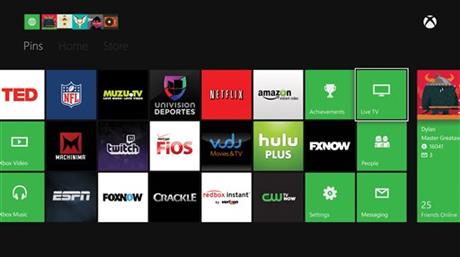
By DERRIK J. LANG
This photo released by Microsoft shows the Xbox One user interface from Microsoft. The successor to the Xbox 360, the Xbox One, is set for release Nov. 22, 2013. (AP Photo/Microsoft)
Games-Xbox One-Kinect
This photo released by Microsoft shows the Xbox One user interface from Microsoft. The successor to the popular Xbox 360, the Xbox One, is set for release Nov. 22, 2013. (AP Photo/Microsoft)
Games-Xbox One-Kinect
FILE – This Aug. 28, 2013 file photo, the Microsoft Xbox One console is on display at the GameStop Expo in Las Vegas. At a recent demonstration of the Xbox One during the first week of November, the successor to the popular Xbox 360 which is set for release Nov. 22, 2013, required several commands to be duplicated in order to pop up on screen. (Photo by Al Powers/Invision/AP, File)
Games-Xbox One-Kinect
FILE – This Sept. 19, 2013 file photo shows models posing in front of an advertisement for Microsoft Xbox One during the Tokyo Game Show 2013 in Makuhari, near Tokyo. The successor to the popular Xbox 360, is set for release Nov. 22, 2013. (AP Photo/Koji Sasahara, File)
XBOX One
In this May 21, 2013 file photo, the Kinect motion-sensing device for Microsoft Corp.’s Xbox One entertainment and gaming console system is on display at an event in Redmond, Wash. The Xbox One, a next-generation entertainment console that promises to be the one system households will need for games, television, movies and other entertainment, goes on sale Nov. 22, 2013. (AP Photo/Ted S. Warren, File)
Prev
1 of 5
Next
LOS ANGELES (AP) — Like a stubborn family member or insubordinate employee, Xbox One owners might need to tell their fancy new console what to do more than once.
In flashy commercials that began airing last week to promote Microsoft’s upcoming video game system, an array of users verbally command their Xbox Ones to do stuff like answer a Skype call, fire up a “Titanfall” match or play the latest “Star Trek” film. The ads leave out one detail: They probably had to repeat themselves a couple of times for it to work.
At a demonstration of the Xbox One this week organized by Microsoft, the new version of the company’s voice-and-motion-detecting Kinect sensor didn’t work nearly as flawlessly in real life. The Xbox 360 successor, which is scheduled for release Nov. 22, required several commands to be repeated for the response to pop up on screen.
During a private 45-minute presentation showcasing the console’s media and entertainment capabilities, about 10 of 45 voice commands issued had to be repeated by a Microsoft spokesman — some as many as four times. Kinect didn’t immediately detect such orders as “Xbox, watch ESPN” and “Xbox, Bing movies with Sandra Bullock” during the demo.
“Everything you’re seeing here is going to get better,” promised Jose Pinero, senior director of marketing and public relations for Xbox, at the conclusion of Wednesday’s demo. “Right now, we’re still a couple of weeks away but voice, the more you use it and the more the system learns, the more accurate it becomes. We’re still working on fit and finish.”
When the company unveiled the Xbox One at its Redmond, Wash., headquarters last May, Microsoft hyped the machine not as a super-powered gaming console but as an all-in-one entertainment solution for living rooms that would allow users to easily switch between — and snap together — activities on a TV screen, without needing to mash buttons.
The previous Kinect sensor was equally billed as a game changer when it debuted in 2010 but was considered by many gamers to ultimately be a gimmick.
Unlike the last Kinect, Microsoft is including the new sensor with each Xbox One system, which will cost $499. The updated version of the camera has a field of vision that’s 60 percent wider than Kinect for Xbox 360. It can also detect more bodies, as well as heart rates and facial expressions.
Sony Corp. will similarly release an updated PlayStation Camera when its PlayStation 4 debuts a week ahead of the Xbox One, but that sensor is optional for the PS4, which cost $100 less than the Xbox One.
“Microsoft got so intoxicated by the first generation of Kinect that I think they’re just assuming people are still really excited about Kinect,” said James McQuivey, Forrester Research analyst and author of “Digital Disruption: Unleashing the Next Wave of Innovation.”
McQuivey said because Microsoft has turned its attention to other audiences besides just gamers, they could potentially sell half as many Xbox Ones as they did Xbox 360s over the next-gen console’s lifetime, especially if the system doesn’t work as advertised.
While the Xbox One’s voice detection did not function properly during Wednesday’s demo, other Xbox One features operated without fault. Graphically, the slick Xbox One interface was able to almost seamlessly switch between such features as playing “Forza Motorsport 5,” watching a live episode of “Let’s Make a Deal” and viewing a channel guide.
Microsoft calls its listings OneGuide, and users can curate which TV channels and media apps appear — and in what order. The Xbox One can play live TV and provide listings if hooked up to a TV receiver, but it can’t act as a TV recording device, although the Xbox One can record and upload footage captured from games and with the Kinect sensor.
Microsoft announced Friday that streaming content apps like Netflix, Hulu Plus, Amazon Instant Video, VUDU and Crackle would be among the first batch coming to the console before spring 2014. Others bringing apps to Xbox One include the networks ESPN, Univision, Fox, CW and HBO, as well as the NFL.


